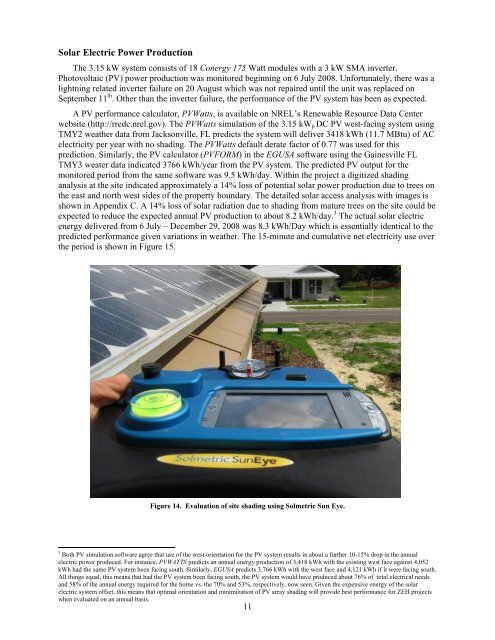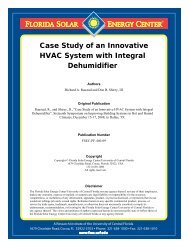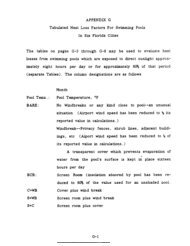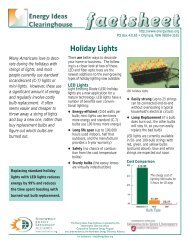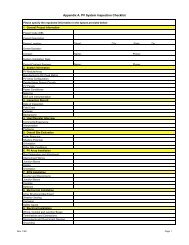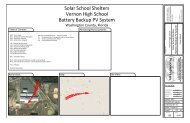Preliminary Performance Evaluation of a Near Zero Energy Home in ...
Preliminary Performance Evaluation of a Near Zero Energy Home in ...
Preliminary Performance Evaluation of a Near Zero Energy Home in ...
Create successful ePaper yourself
Turn your PDF publications into a flip-book with our unique Google optimized e-Paper software.
Solar Electric Power Production<br />
The 3.15 kW system consists <strong>of</strong> 18 Conergy 175 Watt modules with a 3 kW SMA <strong>in</strong>verter.<br />
Photovoltaic (PV) power production was monitored beg<strong>in</strong>n<strong>in</strong>g on 6 July 2008. Unfortunately, there was a<br />
lightn<strong>in</strong>g related <strong>in</strong>verter failure on 20 August which was not repaired until the unit was replaced on<br />
September 11 th . Other than the <strong>in</strong>verter failure, the performance <strong>of</strong> the PV system has been as expected.<br />
A PV performance calculator, PVWatts, is available on NREL’s Renewable Resource Data Center<br />
website (http://rredc.nrel.gov). The PVWatts simulation <strong>of</strong> the 3.15 kWp DC PV west-fac<strong>in</strong>g system us<strong>in</strong>g<br />
TMY2 weather data from Jacksonville, FL predicts the system will deliver 3418 kWh (11.7 MBtu) <strong>of</strong> AC<br />
electricity per year with no shad<strong>in</strong>g. The PVWatts default derate factor <strong>of</strong> 0.77 was used for this<br />
prediction. Similarly, the PV calculator (PVFORM) <strong>in</strong> the EGUSA s<strong>of</strong>tware us<strong>in</strong>g the Ga<strong>in</strong>esville FL<br />
TMY3 weater data <strong>in</strong>dicated 3766 kWh/year from the PV system. The predicted PV output for the<br />
monitored period from the same s<strong>of</strong>tware was 9.5 kWh/day. With<strong>in</strong> the project a digitized shad<strong>in</strong>g<br />
analysis at the site <strong>in</strong>dicated approximately a 14% loss <strong>of</strong> potential solar power production due to trees on<br />
the east and north west sides <strong>of</strong> the property boundary. The detailed solar access analysis with images is<br />
shown <strong>in</strong> Appendix C. A 14% loss <strong>of</strong> solar radiation due to shad<strong>in</strong>g from mature trees on the site could be<br />
expected to reduce the expected annual PV production to about 8.2 kWh/day. 3 The actual solar electric<br />
energy delivered from 6 July – December 29, 2008 was 8.3 kWh/Day which is essentially identical to the<br />
predicted performance given variations <strong>in</strong> weather. The 15-m<strong>in</strong>ute and cumulative net electricity use over<br />
the period is shown <strong>in</strong> Figure 15.<br />
Figure 14. <strong>Evaluation</strong> <strong>of</strong> site shad<strong>in</strong>g us<strong>in</strong>g Solmetric Sun Eye.<br />
3<br />
Both PV simulation s<strong>of</strong>tware agree that use <strong>of</strong> the west orientation for the PV system results <strong>in</strong> about a further 10-15% drop <strong>in</strong> the annual<br />
electric power produced. For <strong>in</strong>stance, PVWATTS predicts an annual energy production <strong>of</strong> 3,418 kWh with the exist<strong>in</strong>g west face aga<strong>in</strong>st 4,052<br />
kWh had the same PV system been fac<strong>in</strong>g south. Similarly, EGUSA predicts 3,766 kWh with the west face and 4,121 kWh if it were fac<strong>in</strong>g south.<br />
All th<strong>in</strong>gs equal, this means that had the PV system been fac<strong>in</strong>g south, the PV system would have produced about 76% <strong>of</strong> total electrical needs<br />
and 58% <strong>of</strong> the annual energy required for the home vs. the 70% and 53%, respectively, now seen. Given the expensive energy <strong>of</strong> the solar<br />
electric system <strong>of</strong>fset, this means that optimal orientation and m<strong>in</strong>imization <strong>of</strong> PV array shad<strong>in</strong>g will provide best performance for ZEH projects<br />
when evaluated on an annual basis.<br />
11


